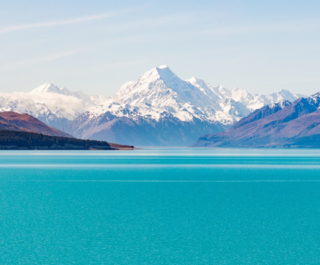
Since Peter Jackson filmed The Lord of the Rings and Hobbit trilogies in New Zealand, both the North and South Islands have seen a boom in tourism from avid fans hoping to walk in the footsteps of their favourite literary characters. Though, perhaps one of the most famous locations that draws fans from around the world is Hobbiton.
This North Island highlight is located in Waikato, approximately 74 kilometres from Rotorua and 180 from Auckland, making it a perfect day trip for all ages. Realised with incredible attention to detail, it's almost impossible to resist its charm. Even more so when you realise the work that went into creating it ...
 One night per week, visitors are treated to a special night tour of the Shire
One night per week, visitors are treated to a special night tour of the Shire1. The Shire is located on a working farm in the heart of Waikato – a 500-hectare sheep farm owned by the Alexander family.
2. Though there are 13,500 sheep on the farm, not one of them appeared in the film. Peter Jackson preferred the dark faces and legs of the Suffolk sheep, which were brought in for filming.
3. When searching for the right filming location, Jackson was looking for a tall tree near a lake/pond that could live up to the Party Tree described in the books. He found it on the Alexander farm. Today, the real life Party Tree stands 70 to 80 metres tall.
 Extreme attention to detail has been put into creating each unique hobbit hole
Extreme attention to detail has been put into creating each unique hobbit hole 4. The Shire was torn down after filming wrapped on The Lord of the Rings trilogy. The set was made mostly of polystyrene and plywood, which was dismantled when filming was complete. Filmmakers had to rebuild the set for The Hobbit movies.
Looking for more North Island fun?
Top 8 New Zealand North Island Experiences
Driving New Zealand: Road Trips For The North Island
5. When rebuilding Hobbiton, it was designed as a permanent fixture using wood, concrete and bricks that had been artificially aged and weathered. It took 70 set builders to complete the work.
6. The set covers 4.8 hectares and features 44 hobbit holes. The holes used by actors playing hobbits were built at 90 per cent scale, while the holes used by Gandalf were built at 60 per cent scale to make him look larger.
 A particular shade of green had to be used to paint the leaves on Bilbo's oak tree
A particular shade of green had to be used to paint the leaves on Bilbo's oak tree 7. The large oak on top of Bag End is completely fake and was constructed specifically for the movie. All of the leaves were individually painted and attached by hand.
8. Speaking of fake trees, the first book of The Lord of the Rings mentions children playing under plum trees. Jackson felt real plum trees would look too big, so he had apple and pear trees planted instead. Just before filming started all the fruit was stripped from the trees and replaced with fake plums. Despite the attention to detail, the scene was cut from the film.
9. The majority of the hobbit homes are just facades covering empty holes. All of the interior shots were filmed in a studio in Wellington so there was no need to build interiors on the set. Bag End is the only hobbit hole with any interior design, which is just a segment of a wall to give the illusion of interiors within when the door is propped open.
 Keep your eye out for the little details surrounding each hobbit hole
Keep your eye out for the little details surrounding each hobbit hole10. There are between 30 and 200 plants around each hobbit hole. Hobbiton employs seven to eight gardeners (five through the winter) to maintain the grounds.
11. While shooting the movies, the frogs in the ponds turned out to be a little too noisy. Peter Jackson paid someone to move all of the frogs to a different pond on the farm.
12. Production crews regulated the length of the grass before and during filming by having sheep eat it.
 Cosy up next to the fireplace for the perfect photo opp
Cosy up next to the fireplace for the perfect photo opp13. The Green Dragon Inn is the newest addition to the set, fully constructed in 2012. It is a real, operational pub with a menu of drinks and light meals.
14. There are three exclusive Southfarthing beverages available at the Green Dragon Inn – an apple cider, ginger beer and two ales – brewed at the Good George Brewery in Hamilton. They are served from the barrels of the Green Dragon Inn.
15. More than 300,000 people from around the world visit Hobbiton every year. In March 2015, the set welcomed its one millionth visitor.











